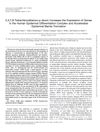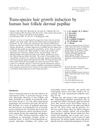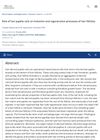TLDR Activating Nrf2 in skin cells causes skin disease similar to chloracne in mice.
The study demonstrated that prolonged activation of the Nrf2 transcription factor in mouse keratinocytes led to skin abnormalities resembling chloracne/MADISH, characterized by sebaceous gland hyperplasia, hyperkeratosis, acanthosis, hair loss, and large keratinized skin cysts. These effects were linked to increased expression of Nrf2 target genes such as Epgn, Slpi, and Sprr2d, which were also upregulated in human keratinocytes in an Nrf2-dependent manner. The findings highlighted the need to consider these potential side effects when using Nrf2-activating compounds for skin protection and cancer prevention.
 86 citations
,
August 2011 in “Toxicological sciences”
86 citations
,
August 2011 in “Toxicological sciences” TCDD speeds up skin barrier formation by increasing certain gene expressions.
33 citations
,
August 2009 in “Journal of Investigative Dermatology” Overexpressing the epigen gene in mice leads to enlarged sebaceous glands and greasy fur.
 January 2022 in “Journal of St. Marianna University”
January 2022 in “Journal of St. Marianna University” Substances from human hair cells can affect hair loss-related genes, potentially leading to new treatments for baldness.
 321 citations
,
December 2009 in “Journal of Dermatological Science”
321 citations
,
December 2009 in “Journal of Dermatological Science” Dermal cells are key in controlling hair growth and could potentially be used in hair loss treatments, but more research is needed to improve hair regeneration methods.
January 2003 in “Chinese Journal of Reparative and Reconstructive Surgery” Dermal papilla cells can help form hair follicles and produce hair.
 66 citations
,
August 2001 in “Experimental Dermatology”
66 citations
,
August 2001 in “Experimental Dermatology” Human hair follicle cells can grow hair when put into mouse skin if they stay in contact with mouse cells.
 57 citations
,
November 1998 in “Wound Repair and Regeneration”
57 citations
,
November 1998 in “Wound Repair and Regeneration” Hair papilla cells can create and regenerate hair bulbs under the right conditions.




